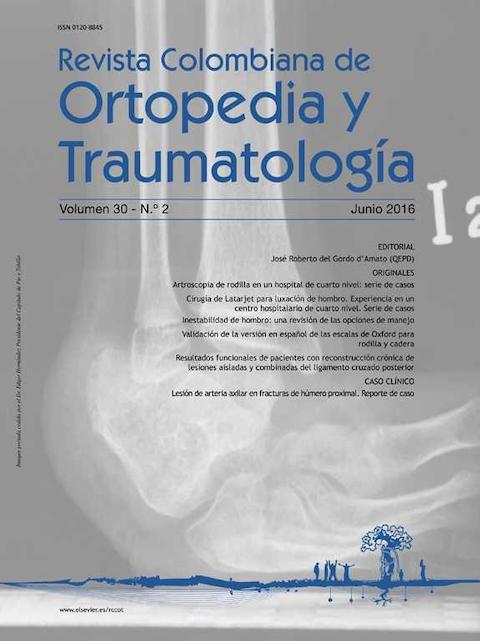Functional results of patients with chronic reconstruction of isolated and combined posterior cruciate ligament (PCL) injuries
DOI:
https://doi.org/10.1016/j.rccot.2016.07.006Keywords:
posterior cruciate ligament, isolated injuries, combined injuries, chronic reconstructionAbstract
Background: Surgical procedures for isolated and combined PCL injuries reconstruction have demonstrated modest results, which require more investigation. The objective of this study was to evaluate the functional results for isolated and combined PCL injuries reconstruction.
Materials & Methods: A retrospective cohort study was made in patients with isolated and combined PCL injuries with grade III instability, treated surgically by ligamentary reconstruction by the same surgeon in one surgical time using diverse techniques. The results were evaluated using Lysholm and Tegner functional scales and postoperative clinical assessment. The mean follow was 66.30 ± 48.06 months (range:12.4-158.6).
Results: General cohort of patients was 29 patients (27 men and 2 women), active militarists, and a total of 30 knees: 17 with isolated PCL injury and 13 combined. (PCL + ACL: 3, PCL + PLC: 5, PCL + ACL + PLC: 5). The mean time between injury and surgical reconstruction was 17 months (range: 4-36). Excellent and good functionality in Lysholm score was of 83.4% and with ability of doing recreational activity and/or competitive activity, with Tegner score of 86.7%. There were not significant differences between isolated and combined PCL reconstruction in Lysholm (p = 0.562) and Tegner (p = 0.202) adjusted by confusion variables. Postoperative physical examination revealed normal posterior drawer and tibial step off in 15 knees (50%) and normal posterolateral stability in 4 knees (66%).
Discussion: There is controversy in the surgical treatment of these injuries; evidence does not go toward any particular surgical technique. Different surgical techniques were used in this study, obtaining good functional results, considering they were product of a refined surgical technique, adequate fixation system and rehabilitation. Chronic reconstruction offers huge functional benefits.
Evidence level: IV.
Downloads
References
Matava MJ, Ellis E, Gruber B. Surgical treatment of posterior cruciate ligament tears: an evolving technique. J Am Acad Orthop Surg. 2009;17:435-46. https://doi.org/10.5435/00124635-200907000-00004
Stannard JP, McKean RM. Anatomic PCL reconstruction: The double bundle inlay technique. Oper Tech Sport Med. 2009;17:148-55. https://doi.org/10.1053/j.otsm.2009.06.005
Shelbourne KD, Davis TJ, Patel DV. The natural history of acute, isolated, nonoperatively treated posterior cruciate ligament injuries. A prospective study. Am J Sports Med. 1999;27: 276-83. https://doi.org/10.1177/03635465990270030201
Shelbourne KD, Muthukaruppan Y. Subjective results of nonoperatively treated, acute, isolated posterior cruciate ligament injuries. Arthroscopy. 2005;21:457-61. https://doi.org/10.1016/j.arthro.2004.11.013
Bergfeld JA, McAllister DR, Parker RD, Valdevit AD, Kambic HE. A biomechanical comparison of posterior cruciate ligament reconstruction techniques. Am J Sports Med. 2001;29:129-36. https://doi.org/10.1177/03635465010290020401
Markolf KL, Zemanovic JR, McAllister DR. Cyclic loading of posterior cruciate ligament replacements fixed with tibial tunnel and tibial inlay methods. J Bone Joint Surg Am. 2002;84- A:518-24. https://doi.org/10.2106/00004623-200204000-00002
Berg EE. Posterior cruciate ligament tibial inlay reconstruction. Arthroscopy. 1995;11:69-76. https://doi.org/10.1016/0749-8063(95)90091-8
Sung-Jae K, Chong-Hyuk C, Hyoung-Sik K. Arthroscopic posterior cruciate ligament tibial inlay reconstruction. Arthroscopy. 2006;20:149-54. https://doi.org/10.1016/j.arthro.2004.04.023
Campbell RB, Jordan SS, Sekiya JK. Arthroscopic tibial inlay for posterior cruciate ligament reconstruction. Arthroscopy. 2007;23:1-4. https://doi.org/10.1016/j.arthro.2007.01.020
Niedzwietzki P, Zantop T, Weimann A, Herbort M, Raschke MJ, Petersen W. Femoral fixation of hamstring grafts in posterior cruciate ligament reconstruction: biomechanical evaluation of different fixation techniques: is there an acute angle effect. Am J Sport Med. 2007;35:780-6. https://doi.org/10.1177/0363546506297906
Margheritini F, Rihn J, Mauro CS, Stabile KJ, Woo SL-Y, Harner CD. Biomechanics of initial tibial fixation in posterior cruciate ligament reconstruction. Arthroscopy. 2013;21:1164-71. https://doi.org/10.1016/j.arthro.2005.06.017
Lysholm J, Gillquist J. Evaluation of knee ligament surgery results with special emphasis on use of a scoring scale. Am J Sport Med. 1982;10:150-4. https://doi.org/10.1177/036354658201000306
Yelverton Tegner JL. Rating systems in the evaluation of knee ligament injuries original tegner.pdf. 1984. p. 43.
Fanelli GC, Giannotti BF, Edson CJ. The posterior cruciate ligament arthroscopic evaluation and treatment. Arthroscopy. 1994;10:673. https://doi.org/10.1016/S0749-8063(05)80067-2
De los Ríos A. Luxación de rodilla. Tratamiento quirúrgico en casos agudos. Rev Col Or Tra. 2005;19:34.
Johnson D. Sports medicine posterior cruciate ligament: a literature review. Curr Orthop Pract. 2010;21:27-31. https://doi.org/10.1097/BCO.0b013e3181c7595c
Larsson RV. Isometry of the lateral collateral and popliteofibular ligaments and techniques for reconstruction using a free semitendinosus tendon graft. Oper Tech Sport Med. 2001;9:84. https://doi.org/10.1053/otsm.2001.21765
Levy B, Stuart MJ, Whelan DB. Posterolateral instability of the knee: evaluation, treatment, results. Sports Med Arthrosc. 2010;18:254-62. https://doi.org/10.1097/JSA.0b013e3181f88527
Fanelli GC EC. Combined posterior cruciate ligament posterolateral reconstructions with Achilles tendon allograft and biceps femoris tendon tenodesis: 2- to 10-year follow-up. Arthroscopy. 2004;4:339. https://doi.org/10.1016/j.arthro.2004.01.034
Lara G. Tratamiento de la inestabilidad rotatoria crónica posteroexterna de la rodilla con aloinjerto de tendón de aquiles. Rev Col Or Tra. 2005;19:43.
Noyes FR, Medvecky MJ. Arthroscopically assisted quadriceps doublé-bundle tibial inlay posterior cruciate ligament reconstruction: an analysis of techniques and a safe operative approach to the popliteal fossa. Arthroscopy. 2003;19:894. https://doi.org/10.1016/S0749-8063(03)00651-0
Markolf KL, Feeley BT, Tejwani SG, Martin DE. Changes in knee laxity and ligament force after sectioning the posteromedial bundle of the posterior cruciate ligament. Arthroscopy. 2006;22:1100. https://doi.org/10.1016/j.arthro.2006.05.018
Kohen RB, Sekiya JK. Single-bundle versus double-bundle posterior cruciate ligament reconstruction. Arthroscopy. 2009;25:1470-7. https://doi.org/10.1016/j.arthro.2008.11.006
Morales F, De los Ríos A. Rehabilitación en lesiones del ligamento cruzado posterior. Rev Col Or Tra. 2006;20:31.
Panchal HB, Sekiya JK. Open tibial inlay versus arthroscopic transtibial posterior cruciate ligament reconstructions. Arthroscopy. 2011;27:1289-95. https://doi.org/10.1016/j.arthro.2011.04.007
Papalia R, Osti L, Del Buono A, Denaro V, Maffulli N. Tibial inlay for posterior cruciate ligament reconstruction: a systematic review. Knee. 2010;17:264-9. https://doi.org/10.1016/j.knee.2010.02.006
Levy BA, Dajani KA, Whelan DB, Stannard JP, Fanelli GC, Stuart MJ, et al. Decision making in the multiligament-injured knee: An evidence-based systematic review. Arthroscopy. 2009;25:430-8. https://doi.org/10.1016/j.arthro.2009.01.008
Downloads
Published
How to Cite
Issue
Section
License
Copyright (c) 2024 Revista Colombiana de ortopedia y traumatología

This work is licensed under a Creative Commons Attribution 3.0 Unported License.




